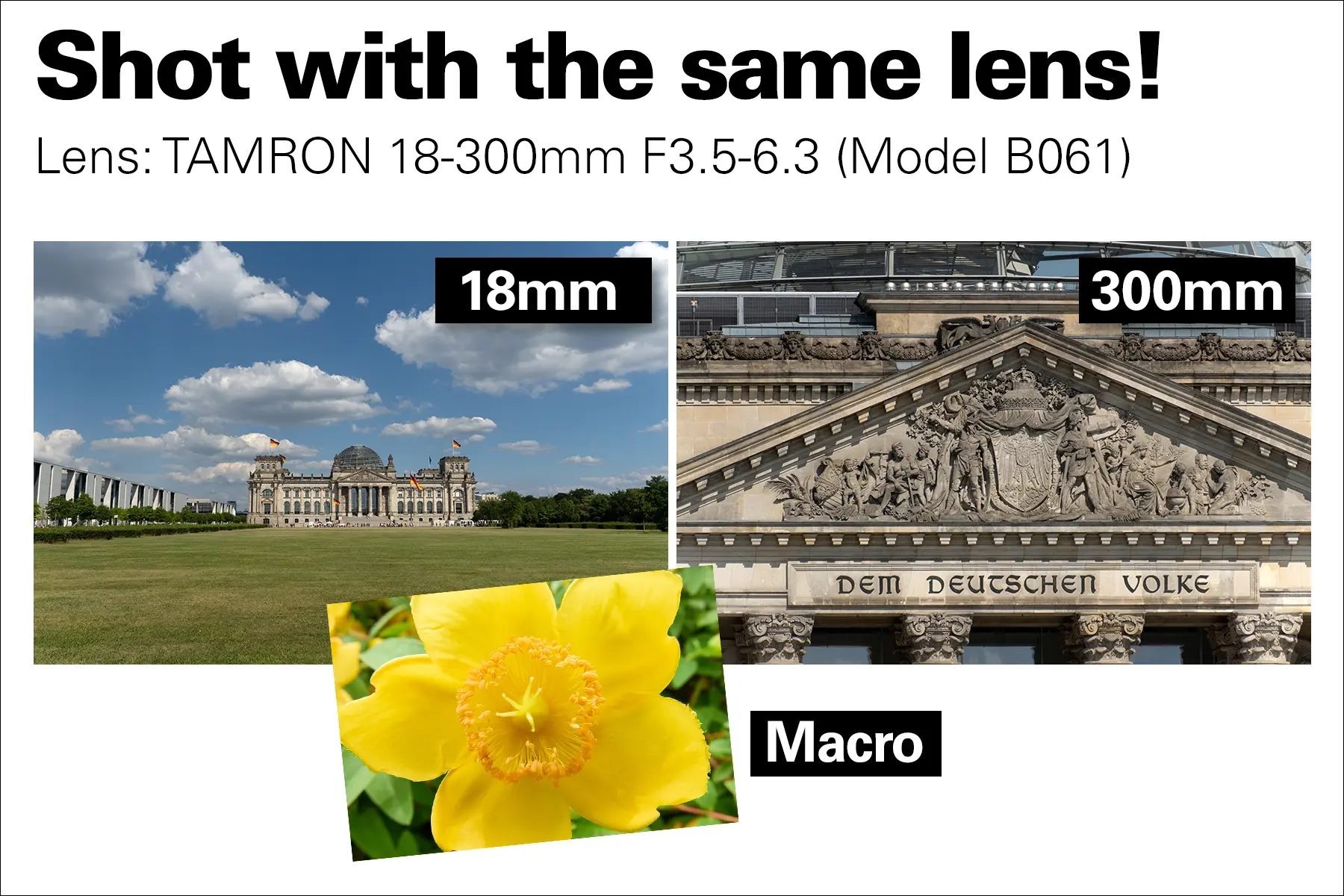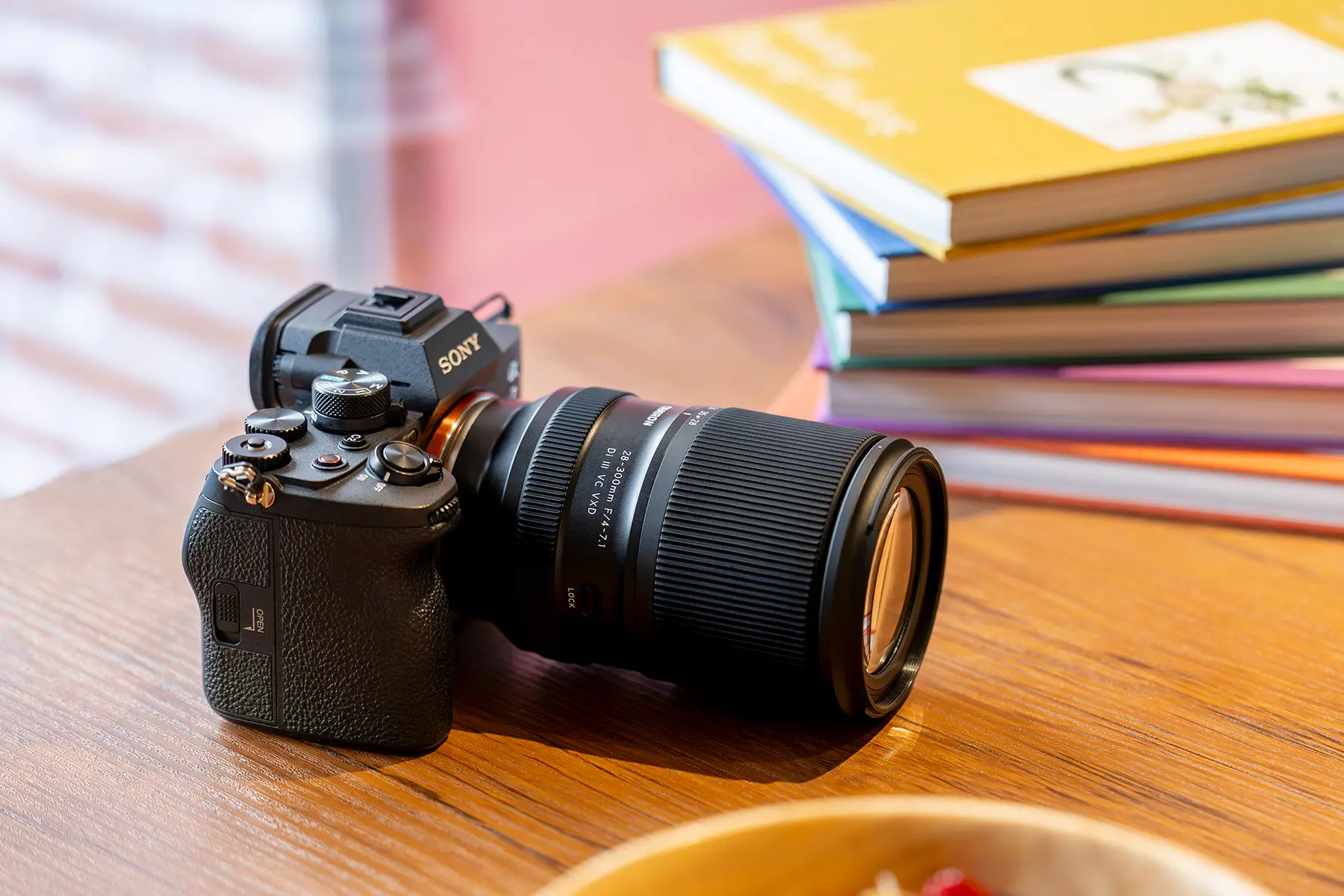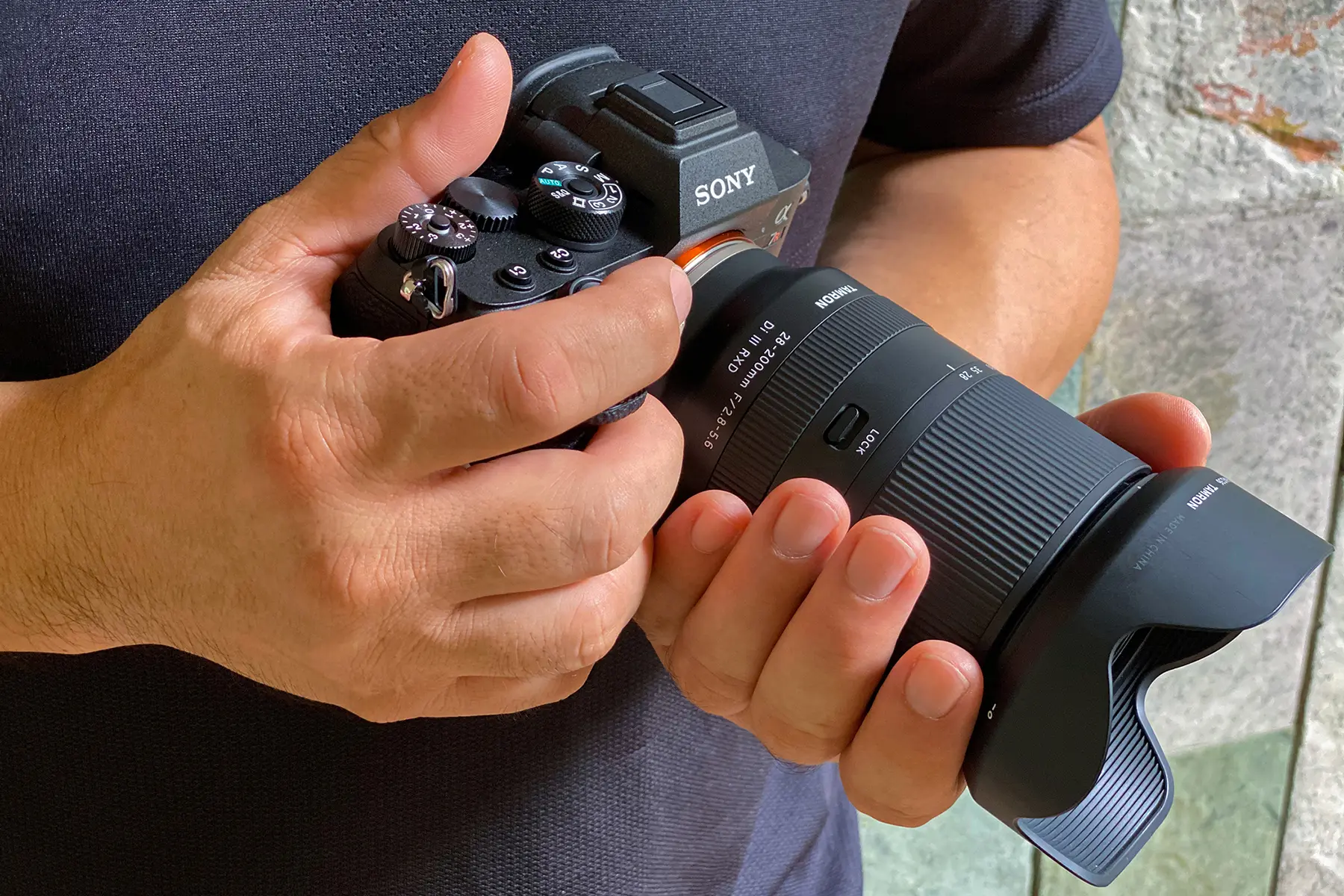If you’ve ever been on a trip juggling multiple lenses and thought, there’s got to be an easier way, you’ve probably asked yourself, what is an all-in-one zoom lens? This versatile lens type covers a wide range of focal lengths—from wide-angle to telephoto—so you can travel lighter, change lenses less often, and still capture a variety of scenes. Whether you’re exploring a new city, photographing an event, or shooting everyday moments, an all-in-one zoom lens gives you the flexibility and convenience to get the shot.
What You’ll Learn In This Article:
- The definition and key features of an all-in-one zoom lens
- Four main advantages of using an all-in-one zoom lens
- The best shooting scenarios for these versatile lenses
- Common drawbacks and how Tamron addresses them
- Standout features of Tamron’s all-in-one zoom lens lineup
What Is an All-in-One Zoom Lens? Definition and How It Works
An all-in-one zoom lens is one with a high zoom ratio. The zoom ratio is calculated as the ratio of the focal length at the wide-angle end to the focal length at the telephoto end, and the higher the zoom ratio, the wider the angle of view it can cover.
For example, if a zoom lens has a wide-angle end of 28mm and a telephoto end of 300mm, the zoom ratio is 300 ÷ 28 = approximately 10.71x.
An all-in-one zoom lens is designed so that the focal length can be easily set to suit the shooting scene and subject, and its main feature is that it can capture a wide range of images from wide-angle to telephoto with just one lens.
All-In-One Zoom Lenses Benefits! 4 Key Advantages
All-in-one zoom lenses cover a wide range from wide-angle to telephoto, and some models even support ultra-telephoto, making them a versatile lens. Here we will introduce four benefits of using all-in-one zoom lenses.
Advantage 1: Wide-Angle to Telephoto in One Lens

As mentioned above, a major advantage of all-in-one zoom lenses is the wide angle of view they can cover. Regular zoom lenses have a limited range of focal lengths, such as “wide-angle to standard” or “standard to telephoto.”
On the other hand, all-in-one zooms cover a wide range of focal lengths, letting you capture a wide range of subject matter with just one lens. The focal lengths covered by all-in-one zoom lenses vary depending on the product, for example, the Tamron 18-300mm F3.5-6.3 (Model B061) for APS-C mirrorless cameras has a focal length of 18mm to 300mm (equivalent to 27-450mm in 35mm full-frame format) and a zoom ratio of 16.6x, covering a wide range from wide-angle to super-telephoto in one lens.
Advantage 2: Adapts to Any Shooting Scene

Another benefit of all-in-one zoom lenses is their flexibility in adapting to a variety of shooting situations. While this is also a feature shared with regular zoom lenses, all-in-one zoom lenses allow for an even wider angle of view.
For example, when shooting landscapes, you can use a wide-angle lens to capture dynamic images of natural scenery and then use a telephoto lens for close-ups of buildings and flowers in the next scene.

With an all-in-one zoom lens, you can easily switch from wide-angle to telephoto without stopping to change lenses. This flexibility means you can capture the moment as it happens, without missing a great shot. And because many all-in-one zoom lenses have a short minimum focusing distance, you can also take close-up photos—adding even more creative possibilities to your photography.
Advantage 3: Travel Light — No Multiple Lenses Needed

Another benefit of an all-in-one zoom lens is that you don’t need to carry multiple lenses. You don’t need a wide-angle lens or a telephoto lens; just one high-magnification zoom lens can handle everything from landscape photography to portrait photography and snapshots.
Carrying multiple lenses can be bulky, but an all-in-one zoom lens can reduce the amount of luggage you need. For example, even if you want to travel light or walk around town, having one lens with you will allow you to enjoy a variety of photography techniques.
Advantage 4: Beginner-Friendly and Easy to Use
Another advantage of an all-in-one zoom lens is how beginner-friendly it is. For new photographers, investing in separate wide-angle and telephoto lenses can feel overwhelming—both financially and in terms of learning how to use them. Plus, if you’re still getting comfortable handling gear, swapping lenses takes time and could mean missing the perfect shot.
With one high-magnification zoom lens, you can photograph a wide variety of subjects and perspectives without buying multiple lenses. And because you never have to stop to change lenses, it’s much easier to capture those decisive moments as they happen.
Best Uses for an All-in-One Zoom Lens
All-in-one zoom lenses are convenient and handy for long-duration shooting, such as at sports events or when traveling. Here we will introduce three recommended shooting situations using all-in-one zoom lenses.
Use Case 1: School and Sports Day Photography

An all-in-one zoom lens is a perfect choice for photographing children’s field days. While you’ll often need a telephoto reach to capture the action from a distance, there are also moments where a wide-angle or standard view is ideal—like photographing the entire venue or a shared lunch.
With an all-in-one zoom lens, you can easily switch between focal lengths to suit the moment. Use the telephoto end to capture running races, then zoom back to a standard view when you’re up close with the kids, all without changing lenses.
Use Case 2: Travel and Vacation Photography

An all-in-one zoom lens is also a great choice for travel photography. With just one lens, you can capture a variety of shots—from close-up photos of meals and table settings to landscapes in national parks, cityscapes and memorable group portraits with friends and family. It also helps lighten your load by eliminating the need to pack separate wide-angle and telephoto lenses.
For travelers who want to stay light on their feet while still being ready for any photo opportunity, an all-in-one zoom lens is the perfect companion.
Nature and Landscape Photography

An all-in-one zoom lens is also perfect for capturing nature and landscapes. You can use the wide-angle end to showcase dramatic scenery like oceans, mountains, or sweeping valleys, then zoom in to photograph distant flowers, wildlife, or trees in detail.

The telephoto range also lets you take advantage of bokeh and compression effects, blurring the background to make your subject stand out. And because you don’t need to carry multiple lenses, your gear stays compact—ideal for hiking or exploring the outdoors when you want to travel light.
Use Case 4: Videography With a Mirrorless Camera
All-in-one zoom lenses are useful not only for photography but also for videography. When shooting video, you need to frequently adjust the focus and zoom in and out.
By using an all-in-one zoom lens, you can adjust the zoom without changing your shooting position, adding more variety and rhythm to your video. You can easily shoot videos in a variety of situations, such as filming sports events or vlogs.
All-in-One Zoom Lens Drawbacks and How to Handle Them
Although all-in-one zoom lenses are versatile, they do have some drawbacks. Here are three general points to keep in mind when using all-in-one zoom lenses.
Point 1: Larger Than a Standard Kit Lens
A typical all-in-one zoom lens is larger than a standard kit lens. Because it covers such a wide range of focal lengths—from wide-angle to telephoto—it contains more lens elements and a more complex internal structure. For this reason, it’s a good idea to handle the camera and lens together before buying, so you can get a feel for the balance, grip, and weight in your hands.
Point 2: Smaller Maximum Aperture
One thing to keep in mind with all-in-one zoom lenses is that their maximum aperture is typically smaller than that of fast zooms, such as a 28-75mm F2.8. However, it’s still comparable to most standard kit lenses that come packaged with a camera. The trade-off for their impressive focal range and versatility is a slightly smaller aperture, which is a natural result of their complex optical design.
While this means you may need to adjust settings or use additional lighting in darker environments, it also encourages creative shooting techniques—like slower shutter speeds, higher ISO, or image stabilization—to get beautiful results in a wide range of conditions.
Slightly Less Sharp Than Prime Lenses
While some say all-in-one zoom lenses can’t match the absolute sharpness of certain prime or specialty zoom lenses, their resolution is more than high enough for everyday photography. For most situations, they deliver image quality comparable to regular zooms or primes, making them an excellent choice for travel, events, and general use.
When you push resolution to the extreme—such as in commercial or high-end creative work—you may notice subtle differences in fine detail. In those cases, pairing your all-in-one zoom with a prime or a premium zoom can give you the best of both worlds: top-tier image quality when needed, and unbeatable versatility for everything else.
Tamron All-in-One Zoom Lenses: Key Features
Tamron’s all-in-one zoom lenses are designed with advanced technologies that address the common drawbacks of this lens type, delivering impressive image quality in a lightweight, compact form. They’re built for photographers who want convenience without compromising performance.
Below, we’ll walk through five standout features that make Tamron’s all-in-one zoom lenses a smart choice for a wide range of shooting styles.
Feature 1: Bright Aperture and High Image Quality

The Tamron 28-200mm F2.8-5.6 (Model A071) combines a high zoom ratio—from wide 28mm to telephoto 200mm—with an impressively bright maximum aperture of f/2.8 at the wide end. This brightness makes it easier to maintain image quality in low-light situations, even when narrowing the aperture or increasing the shutter speed.
The fast f/2.8 aperture also allows for beautiful background blur and nuanced image expression across a variety of scenes. It’s an excellent choice for photographers who want the versatility of an all-in-one zoom lens without sacrificing bokeh or imaging performance.
Feature 2: Lightweight and Compact Design

Another standout feature of Tamron’s all-in-one zoom lenses is their lightweight, compact design. Thanks to advanced optical engineering, they rank among the lightest and most compact high-magnification zoom lenses available.
For example, the Tamron 18-300mm F3.5-6.3 (Model B061) is remarkably portable—measuring just 4.9” long and weighing only 21.9oz. (Sony E-mount) This makes it an ideal companion for travel, outdoor adventures, and any situation where you want powerful zoom capabilities without the bulk.
Feature 3: Exceptional Close-Up Shooting Ability

Tamron’s all-in-one zoom lenses also stand out for their impressive close-up shooting capabilities. While many all-in-one zooms have relatively long minimum focusing distances, the Tamron 28-300mm F4-7.1 (Model A074) can focus as close as 7.5” at the 28mm wide-angle end, achieving a maximum magnification ratio of 1:2.8. This short focusing distance lets you get up close to your subject to capture the intricate details of flowers, insects, and other small subjects.
Even at the 300mm telephoto end, the lens maintains a close minimum focusing distance of just 39”, giving you creative flexibility for close-up photography across the entire zoom range.
Feature 4: Wide-Angle to Super-Telephoto Coverage

The Tamron 18-300mm F3.5-6.3 (Model B061) offers one of the highest zoom ratios available in an all-in-one zoom lens. Covering a focal range from 18mm to 300mm—equivalent to 27-450mm in full-frame format—it delivers an impressive 16.6x zoom ratio.
This expansive range lets you seamlessly switch from wide-angle landscapes and architecture to super-telephoto shots of distant subjects.

Incredibly versatile, it’s a lens that can handle everything from scenery to fast-moving subjects like kids, airplanes and trains, as well as wildlife and sports photography.
Feature 5: Fast, Precise, and Quiet Autofocus
Tamron’s all-in-one zoom lenses also excel in autofocus (AF) performance, delivering fast, precise focusing that helps you lock onto your subject with ease. This makes them especially reliable when you need quick, accurate focus tracking—such as photographing sports, birds in flight, or other moving subjects.
Another advantage is their exceptionally quiet AF operation, which is ideal for situations where even minimal noise could be disruptive, like wildlife photography, indoor events, or videography. With speed, accuracy, and silence, Tamron’s AF system is designed to help you capture the moment without distraction.
Tamron’s High-Magnification Zoom Lens Lineup
Tamron 18-300mm F/3.5-6.3 Di III-A VC VXD (Model B061)

Purpose-built for APS-C format mirrorless cameras, the Tamron 18-300mm F3.5-6.3 offers a massive 16.6x zoom ratio. This lens covers ultra-wide to super-telephoto and even 1:2 macro, making it a one-lens-does-it-all solution for nearly any shooting scenario.
Available Mounts: Sony E-mount, Canon RF mount, Fujifilm X-mount, and Nikon Z mount (APS-C)
Top Features:
- 6x zoom ratio (27-450mm full-frame equivalent*)
- VXD linear motor for fast, precise autofocus
- magnification ratio 1:2 at 5.9” MOD at 18mm
- Built-in VC (Vibration Compensation) for steady handheld shots
- Compact design at just 21.9oz and 4.9” long with a 67mm filter size, perfect for travel and all-day shooting
- Moisture-resistant construction and fluorine coating for confidence in inclement weather
*Specs for the Sony E-mount model
Tamron 28-200mm F/2.8-5.6 Di III RXD (Model A071)

Designed for full-frame mirrorless cameras, the Tamron 28-200mm F2.8-5.6 is a groundbreaking all-in-one zoom lens that starts at a bright F2.8 aperture at the wide end—rare for its class. It delivers excellent image quality across the zoom range in a compact and lightweight package, making it ideal for travel and everyday photography.
Available Mounts: Sony E-mount (Full-frame)
Top Features:
- Bright F2.8 aperture at the wide-angle end for beautiful background blur
- 5” minimum focusing distance at 28mm for close-up shooting (max. magnification ratio 1:3.1)
- Compact and lightweight design at just 4.6” long and 20.3oz with 67mm filter size
- RXD (Rapid eXtra-silent stepping Drive) for fast, quiet autofocus
- Moisture-resistant construction and fluorine coating for outdoor reliability
Tamron 28-300mm F4-7.1 Di III VXD (Model A074)

Covering everything from wide-angle to super-telephoto, the Tamron 28-300mm F4-7.1 is a versatile, high-magnification zoom for full-frame mirrorless cameras. Its long reach and close-focusing ability make it equally suitable for travel, portraits, wildlife, and casual macro work.
Available Mounts: Sony E-mount (Full-frame)
Top Features:
- Expansive 10.7x zoom ratio from 28mm to 300mm
- Close focusing down to 7.5” at 28mm (max. magnification ratio 1:3.8)
- Lightweight and portable at just 21.5oz. and 5” long with a 67mm filter size
- VXD linear motor for fast, precise autofocus
- Moisture-resistant construction and fluorine coating for shooting confidence in varied conditions
Conclusion: Why an All-in-One Zoom Lens Belongs in Your Kit
All-in-one zoom lenses span a wide range of focal lengths—from wide-angle to telephoto—making them incredibly versatile for countless shooting situations. They’re equally at home capturing casual snapshots, action-packed events like sports days, or dynamic travel landscapes.
Tamron’s All-in-one zoom lenses, particularly those designed for Sony E, Canon RF, Fujifilm X, and Nikon Z mount mirrorless cameras, pair lightweight, compact construction with impressive image quality.
If you’re exploring the idea of adding an all-in-one zoom lens to your kit, this guide is the perfect place to start.
Learn more about Tamron all-in-one zoom lenses at an authorized Tamron dealer near you or visit the TAMRON Store.
